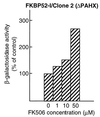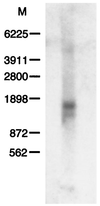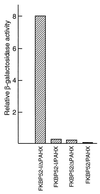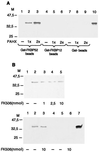Immunophilins, Refsum disease, and lupus nephritis: the peroxisomal enzyme phytanoyl-COA alpha-hydroxylase is a new FKBP-associated protein
- PMID: 10051602
- PMCID: PMC26744
- DOI: 10.1073/pnas.96.5.2104
Immunophilins, Refsum disease, and lupus nephritis: the peroxisomal enzyme phytanoyl-COA alpha-hydroxylase is a new FKBP-associated protein
Abstract
FKBP52 (FKBP59, FKBP4) is a "macro" immunophilin that, although sharing high structural and functional homologies in its amino-terminal domain with FKBP12 (FKBP1), does not have immunosuppressant activity when complexed with FK506, unlike FKBP12. To investigate the physiological function of FKBP52, we used the yeast two-hybrid system as an approach to find its potential protein partners and, from that, its cellular role. This methodology, which already has allowed us to find the FK506-binding protein (FKBP)-associated protein FAP48, also led to the detection of another FKBP-associated protein. Determination of the sequence of this protein permitted its identification as phytanoyl-CoA alpha-hydroxylase (PAHX), a peroxisomal enzyme that so far was unknown as an FKBP-associated protein. Inactivation of this enzyme is responsible for Refsum disease in humans. The protein also corresponds to the mouse protein LN1, which could be involved in the progress of lupus nephritis. We show here that PAHX has the physical capacity to interact with the FKBP12-like domain of FKBP52, but not with FKBP12, suggesting that it is a particular and specific target of FKBP52. Whereas the binding of calcineurin to FKBP12 is potentiated by FK506, the specific association of PAHX and FKBP52 is maintained in the presence of FK506. This observation suggests that PAHX is a serious candidate for studying the cellular signaling pathway(s) involving FKBP52 in the presence of immunosuppressant drugs.
Figures





Similar articles
-
Identification of PAHX, a Refsum disease gene.Nat Genet. 1997 Oct;17(2):185-9. doi: 10.1038/ng1097-185. Nat Genet. 1997. PMID: 9326939
-
FAP48, a new protein that forms specific complexes with both immunophilins FKBP59 and FKBP12. Prevention by the immunosuppressant drugs FK506 and rapamycin.J Biol Chem. 1996 Dec 20;271(51):32923-9. doi: 10.1074/jbc.271.51.32923. J Biol Chem. 1996. PMID: 8955134
-
Mutation of FKBP associated protein 48 (FAP48) at proline 219 disrupts the interaction with FKBP12 and FKBP52.Regul Pept. 2001 Mar 2;97(2-3):147-52. doi: 10.1016/s0167-0115(00)00206-8. Regul Pept. 2001. PMID: 11164950
-
FKBP family proteins: immunophilins with versatile biological functions.Neurosignals. 2008;16(4):318-25. doi: 10.1159/000123041. Epub 2008 Jul 18. Neurosignals. 2008. PMID: 18635947 Review.
-
FK506 and the role of immunophilins in nerve regeneration.Mol Neurobiol. 1997 Dec;15(3):285-306. doi: 10.1007/BF02740664. Mol Neurobiol. 1997. PMID: 9457703 Review.
Cited by
-
Comprehensive analysis of FKBP4/NR3C1/TMEM173 signaling pathway in triple-negative breast cancer cell and dendritic cell among tumor microenvironment.Mol Ther Oncolytics. 2022 Jan 4;24:371-384. doi: 10.1016/j.omto.2021.12.024. eCollection 2022 Mar 17. Mol Ther Oncolytics. 2022. Retraction in: Mol Ther Oncolytics. 2022 May 10;25:263. doi: 10.1016/j.omto.2022.05.002. PMID: 35118194 Free PMC article. Retracted.
-
Transcriptome analysis of growth heterosis in pearl oyster Pinctada fucata martensii.FEBS Open Bio. 2018 Oct 12;8(11):1794-1803. doi: 10.1002/2211-5463.12502. eCollection 2018 Nov. FEBS Open Bio. 2018. PMID: 30410859 Free PMC article.
-
Naringenin Regulates FKBP4/NR3C1/NRF2 Axis in Autophagy and Proliferation of Breast Cancer and Differentiation and Maturation of Dendritic Cell.Front Immunol. 2022 Jan 11;12:745111. doi: 10.3389/fimmu.2021.745111. eCollection 2021. Front Immunol. 2022. PMID: 35087512 Free PMC article.
-
[Adult Refsum disease. A retinal dystrophy with therapeutic options].Ophthalmologe. 2005 Aug;102(8):772-7. doi: 10.1007/s00347-005-1239-x. Ophthalmologe. 2005. PMID: 15990985 Review. German.
-
Non-manifesting Refsum heterozygotes carrying the c.135-2A>G PAHX gene transition.Neurol Sci. 2008 Jun;29(3):173-5. doi: 10.1007/s10072-008-0931-4. Epub 2008 Jul 9. Neurol Sci. 2008. PMID: 18612766
References
Publication types
MeSH terms
Substances
Associated data
- Actions
LinkOut - more resources
Full Text Sources
Molecular Biology Databases
Miscellaneous

